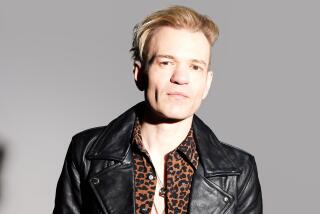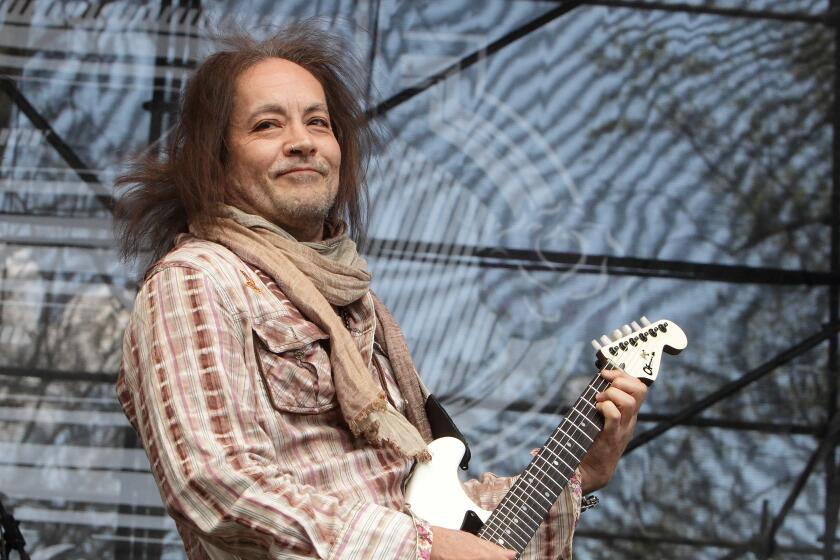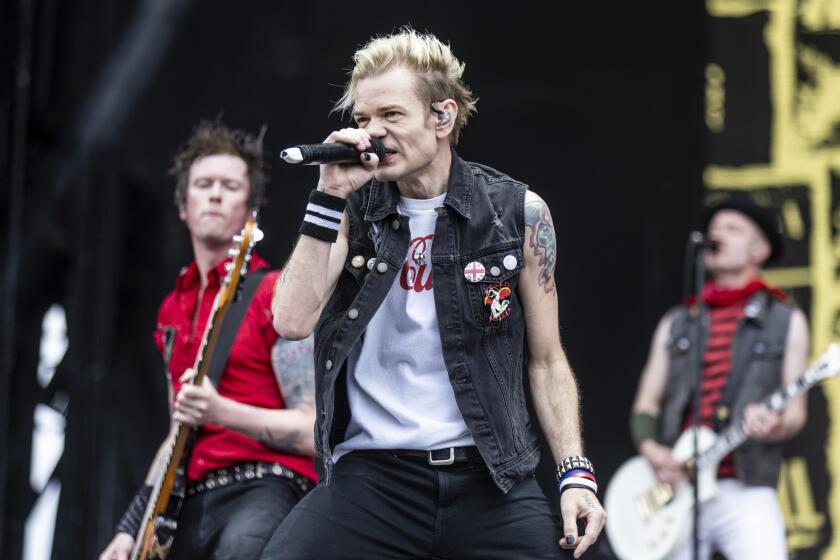Obscure S.D. Samba Band to Be Instrumental Part of Show
San Diego is home to a broad spectrum of exotic art forms. Unfortunately, many never make their way to the formal concert stage. They exist in relative obscurity among the underground fringe, surfacing only sporadically for nightclub engagements or public gatherings.
Escola de Samba Sol E Mar Samba Band, an instrumental group that thrives on the relentless rhythms of Rio de Janeiro, is a prime example. The musicians in this carnival samba band have been playing together about four years. Yet few San Diegans even know the ensemble exists.
“We pop up now and then,” said Kevin Delgado, leader of the band, “but we’ve never performed in a concert. We play at parades and private parties or little festivals. Nothing big-time. All our publicity has been low-key so far.”
That could change if the group’s gig this weekend is a success. The band--which had its genesis in a world music class at San Diego State University--has been invited to appear as the opening act for “A Concert of Latin Rhythms” at SDSU’s Studio Theatre tonight and Saturday.
“There are about eight musicians in our core group,” Delgado said. “When we first heard the samba music, we were hooked. This year, five of us went down to live in Rio for two months (during carnival time) to absorb what we could of carnival music.
“We didn’t march in the parade,” he said, “because we were too late to qualify (carnival plans are set about a year in advance), but we got to practice with the musicians. At first, they were a little hesitant about accepting Americans, but then we were welcomed into the group.”
As Delgado pointed out, the batucada (carnival samba music) evolved from the rapid-fire rhythms of Africa’s throbbing drum beats.
“The samba (consists) only of drums, one little guitar, and singing. There are a lot of really strong percussives--big bass sounds--and the cuica (pronounced queeka) sounds like a dog. It’s sort of a yelp.
“The blacks that came to America developed jazz. In Brazil, the African music became samba. Jazz swings, but samba has got its own flavor. It’s hard to put into words, but it’s hypnotic and rhythmically very complex--and it’s joyful music even though it comes from (a land of) poverty and racism.
“The music reflects a big part of the spirit of the (Brazilian) people, but its roots are definitely African.
“There are all kinds of drums in a samba band. For the carnival, there are about 400 drummers in each group marching in the parade, and there are several groups marching. It’s really an incredible sound as it passes you by.”
Steve Epstein, another veteran member of the ensemble, was among the Sol E Mar musicians on the pilgrimage to Rio. Like several band members, he has a 9-to-5 job, but samba is his “obsession.” His research in Rio convinced him of that.
“Brazilians are very serious about their samba band,” Epstein said. “Each neighborhood has its own escola , its own samba band, just like everybody here has its own football team. And we’re talking 300 to 400 musicians in each band. Carnival is the biggest event of the year for them, and they get all wrapped up in it.”
Epstein is convinced the Sole E Mar Samba Band can stir up the same kind of excitement for local audiences. The rousing response that has greeted the group during its few local performances is proof enough for him.
“You can’t keep people in chairs,” he said. “It’s dance music, and people just want to get up and move when they hear us. We performed in the Toyland Parade in North Park in November and won best band in the parade.”
Delgado, on the other hand, is more apprehensive about the band’s concert debut.
“We’re so loud,” he said, “I don’t know how that will work out indoors. This is a new thing for us, and some of our best musicians are still in Brazil, so we’ll only be playing at about half strength. I wish I had all my best (musicians) here now.”
Meanwhile, after the samba band gives its high-decibel performance, Rayna’s Spanish Ballet will make one of its rare concert appearances. The company’s fiery mix of flamenco footwork, arched backs, and snapping fingers, is familiar to local aficionados because since Rayna, a former dancer with the great Jose Greco, performs in the al fresco ambiance of Old Town on Sunday afternoons. Her concert appearances, however, are few and far between.
Rayna’s company, on this occasion, will have no male protagonists to create the smoldering battle of the sexes that ignites much of the passion in flamenco dance. But there will be five additional female dancers--accompanied by the obligatory Spanish guitar music and throaty chants of a songstress--to conjure up the proud spirit of pure flamenco dance.
Why is a Brazilian samba band teaming up with a flamenco troupe?
George Willis, director of the dance program at San Diego State, explained his motivation for this odd pairing.
“They’re both Latin forms, and some things in their structure have a commonality,” he said. “They both have improvisational elements, for example, and they both focus on rhythm. I think they’ll make an exciting concert.”
More to Read
The biggest entertainment stories
Get our big stories about Hollywood, film, television, music, arts, culture and more right in your inbox as soon as they publish.
You may occasionally receive promotional content from the Los Angeles Times.










